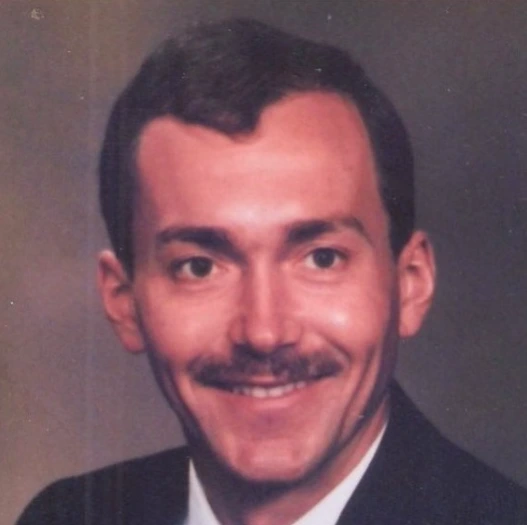
The Death of Captain Gordon Hess
A Respected Leader Found Dead
Captain Gordon Hess was everything you'd want in a military officer and community leader. At 38 years old, he served as a National Guard Company Commander while also working as a respected firefighter in Jamestown, New York. By all accounts, he was a dedicated professional with a stable personal life and no history of mental health issues or suicidal behavior.
That's what made the discovery of his body at Fort Knox so shocking. On March 4, 1998, Hess was found face-down in a shallow creek in a ravine, lying in about an inch of bloody water. His gray sweatshirt had a small hole near the breastbone, and his body bore multiple stab wounds.
The scene was immediately compromised. Four soldiers who recovered the body reported that they found no weapon at the scene, but the Army later provided crime scene photos showing a Leatherman knife partially obscured by an oak leaf. The soldiers noted that Hess's body was already stiff, his face had turned purple, and his arms were clenched near his chest. They also stated that no one else had touched the body before their arrival.
Within hours, the Army was treating this as a potential homicide. Hess's family was initially notified that the military was investigating a murder. But then something changed.
The Army's Quick Conclusion
On March 5, 1998, U.S. Army pathologist Dr. Peter Schilke conducted an autopsy that revealed the full extent of Hess's injuries. The captain had suffered 26 wounds: six superficial wounds to his neck and 20 wounds to his chest. Two of the chest wounds had penetrated his heart, five had pierced his left lung, and one had damaged his liver.
Despite this extensive trauma, Dr. Schilke ruled the death a suicide. His reasoning was based on several factors: he interpreted the superficial neck wounds as "hesitation marks" commonly seen in suicide attempts, noted the absence of defensive wounds that might indicate a struggle, and pointed to the presence of Hess's wallet (with cash still inside) and the Leatherman knife at the scene as evidence that this wasn't a robbery gone wrong.
On March 10, just six days after finding the body, the Army publicly declared Captain Hess's death a suicide. The speed of this conclusion would prove to be one of many troubling aspects of the investigation.
A Family's Fight for Truth
The Hess family, along with his friends and the entire Jamestown community, were stunned by the suicide ruling. This was a man they knew well – someone who showed no signs of depression, had no history of mental health issues, and seemed to be thriving both personally and professionally.
The family's lawyer, Charles De Angelo, immediately halted funeral proceedings and arranged for an independent second autopsy. On March 10, 1998, Dr. Sung-ook Baik examined Hess's body at the Lind Funeral Home in Jamestown and reached a dramatically different conclusion.
Dr. Baik identified the same wounds that Dr. Schilke had found – multiple stab wounds to the neck, chest, heart, lung, liver, and ribs – but interpreted them completely differently. In his professional opinion, this was clearly a homicide, not a suicide.
The family didn't stop there. They engaged multiple independent forensic pathologists to review the case, including some of the most respected names in the field: Dr. Dominick J. Di Maio, Dr. Leslie Lukash, Dr. Halbert E. Fillinger, and Dr. Barbara Wolf. These experts had decades of combined experience in forensic pathology and had testified in countless criminal cases.
Their unanimous conclusion? This was not a suicide.
The Expert Analysis
The independent forensic experts identified several key problems with the Army's suicide ruling that should concern anyone interested in forensic integrity.
First, they noted the absence of true hesitation wounds. While Dr. Schilke had interpreted the superficial neck wounds as hesitation marks, the independent experts pointed out that genuine hesitation wounds in suicides typically show a pattern of increasingly deeper cuts as the person works up the courage to inflict fatal damage. The wounds on Captain Hess didn't follow this pattern.
Second, the wounds were described as "deep and haphazardly oriented," including at least one "Y"-shaped wound. This type of wound pattern is extremely unusual in suicides, where victims typically inflict wounds in a more systematic manner.
Third, many of the wounds had gone through Hess's clothing. While not impossible in suicide cases, wounds through clothing are much more common in homicides, particularly when the victim is trying to defend themselves or when an attacker is stabbing through fabric.
Perhaps most importantly, the experts noted that the Leatherman knife found at the scene had a 2.5-inch non-locking blade. This type of blade would be extremely difficult to use for the kind of deep, penetrating wounds found on Hess's body because it would likely fold back on the user's hand during a forceful stabbing motion. Additionally, no fingerprints were found on the knife, despite it being covered in Hess's blood from the bloody water where his body was discovered.
The Compromised Crime Scene
The problems with this case extend far beyond the autopsy findings. The crime scene itself was heavily compromised from the beginning, raising serious questions about the Army's commitment to a thorough investigation.
Multiple responders and commanders trampled through the area, leaving footprints and other contamination. Someone left a coffee container at the scene. Most shocking of all, within days of the body's discovery, the Army dumped two tons of dirt on the site, claiming it was necessary to prevent biohazards.
This action destroyed any possibility of collecting additional forensic evidence like soil samples that might have contained trace evidence from the killer, or boot prints that could have been compared to potential suspects. It's hard to interpret this as anything other than a deliberate attempt to prevent further investigation.
The Army's Theory
So why was the Army so convinced this was a suicide? Their investigation focused heavily on what they called a "fratricide incident" that had occurred during a simulation exercise. According to their theory, Captain Hess had become severely depressed after mistakenly "destroying" allied units during the training exercise.
The Army interviewed Lieutenant John Burris, who was described as Hess's friend, along with other personnel who knew the captain. None of these interviews revealed any suicidal tendencies or behavior that would suggest Hess was contemplating taking his own life. In fact, the "fratricide incident" was later determined to have been caused by another unit's navigational error, not anything Hess had done wrong.
Despite this, the Army's psychological autopsy, conducted by Dr. Michael Gelles, speculated that Hess's supposed perfectionism had led to a psychotic break that resulted in his suicide. This theory wasn't supported by Hess's stable psychological history, his performance records, or toxicology reports that showed no drugs or alcohol in his system.
Political Intervention and Continued Stonewalling
The case attracted the attention of Congressman Amo Houghton, who intervened on behalf of the Hess family and demanded answers from the Army. Despite this political pressure, military officials maintained their suicide ruling.
However, in December 1998, the Army quietly amended Captain Hess's casualty report from "suicide" to "undetermined." This change was likely made to reduce public outcry rather than because of any new evidence or genuine reconsideration of the case.
The amendment satisfied no one. The family continued to believe their loved one had been murdered, while the Army's actions suggested they knew their original conclusion was questionable but weren't willing to admit they might have been wrong.
An Independent Investigation
A seasoned homicide investigator who served as a consultant on the case concluded that the evidence strongly indicated homicide rather than suicide. The consultant cited the severity of the wounds, the complete absence of genuine hesitation marks, and Hess's robust psychological profile as key factors in reaching this conclusion.
The investigation was criticized for several major flaws:
- Bias from the beginning: The Army seemed determined to reach a suicide conclusion rather than following the evidence wherever it led
- Reliance on misinterpreted evidence: The supposed "hesitation wounds" that didn't actually fit the pattern of genuine hesitation marks
- Questionable forensic analysis: Bloodstain pattern analysis that was conducted months after the scene had been contaminated and covered with dirt
- Destruction of evidence: The decision to dump tons of dirt on the crime scene before a thorough investigation could be completed
The Questions That Remain
More than 25 years later, the death of Captain Gordon Hess remains officially "undetermined," but the questions surrounding his case are as troubling as ever. If this was indeed a homicide, as multiple independent experts concluded, then someone got away with murder while the U.S. Army covered up the crime – whether intentionally or through gross incompetence.
The case raises serious concerns about how the military investigates deaths on its installations. Are soldiers and officers getting the same level of forensic investigation that civilians would receive? When the military's reputation is at stake, do they prioritize damage control over justice?
What's particularly disturbing is the pattern of behavior we see from Army officials: the quick rush to judgment, the destruction of evidence, the refusal to seriously consider alternative theories even when presented with expert testimony from respected forensic pathologists.
If Captain Hess was murdered, the killer was almost certainly someone with access to Fort Knox and knowledge of his whereabouts. This suggests the perpetrator was likely another service member or someone connected to the base. The Army's determination to classify this as a suicide may have allowed a killer to escape justice and potentially harm others.
The Broader Implications
The Gordon Hess case isn't just about one man's death – it's about institutional accountability and the lengths to which organizations will go to protect their reputation. When multiple independent forensic experts with impeccable credentials all reach the same conclusion that contradicts an official finding, we should take notice.
This case also highlights the importance of having independent oversight of military investigations. When the Army investigates itself, there's an inherent conflict of interest that can compromise the search for truth. The families of service members deserve better than investigations that seem designed to reach predetermined conclusions.
The speed with which the Army moved to classify this as a suicide, combined with their destruction of evidence and refusal to reconsider their findings even when presented with compelling contrary evidence, suggests a system more concerned with avoiding embarrassment than seeking justice.
A Family's Continuing Pain
For the Hess family, the official "undetermined" classification provides no closure. They know that multiple forensic experts concluded their loved one was murdered, yet the person responsible has never been identified or prosecuted. They've had to live with the knowledge that the institution Captain Hess served faithfully may have failed him in the most fundamental way possible.
The case serves as a reminder that sometimes the biggest obstacle to justice isn't a lack of evidence or investigative techniques – it's institutional pride and the unwillingness to admit when mistakes have been made.
Seeking Truth and Justice
Today, the death of Captain Gordon Hess remains one of the most troubling examples of a potentially botched military investigation. The physical evidence, the expert testimony, and the compromised crime scene all point to serious problems with the Army's handling of this case.
While we may never know exactly what happened in that ravine at Fort Knox on March 4, 1998, we can learn from the mistakes that were made in the investigation. We can demand better transparency and accountability from military investigators. And we can remember that Captain Gordon Hess deserved better than what he got from the institution he served.
Sources
https://www.latimes.com/archives/la-xpm-1999-jun-27-mn-50614-story.html
https://www.militaryfamiliesforjustice.org/captain-gordon-hess
